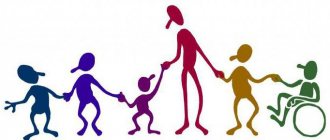The uniqueness of a person is determined not only by his inner world, but also by the totality of personality qualities that influence the individual’s attitude towards life and the people around him. To realize the uniqueness of each inhabitant of the Earth, it is necessary not only to know how personality traits are understood in psychology, but also to be able to notice the main individual psychological characteristics of a person.
Personality traits
Is a person a person?
Man is a creature that arose as a result of evolution, capable of living in society and conducting socio-historical activities. A person is constantly studying and changing the world around him, developing culture and building his own life.
Various sciences study the origin, development, and purpose of man in the world: religion, philosophy, psychology, biology.
Each person is an individual who has his own idea of the world, society, culture and activity.
Is an individual a person?
An individual is a person who has an individual set of acquired and innate skills, abilities, and qualities. The individual is also recognized as a person as a separate representative of humanity, but these concepts still cannot be identified.
An individual is any representative of society, regardless of his social status, age and gender. High social organization allows an individual to cope with innate biological limitations, change behavior and control internal psychological processes.
A person is a person who knows how to build his own life line and controls behavior in order to achieve better results. Psychologists believe that an individual is able to become an individual only through constant communication with other people and leading an active social lifestyle.
An example of a finished psychological portrait
To make it clear to you what a psychological portrait should look like, I will give you a ready-made example of a portrait of a well-known literary character. Unfortunately, it is not possible to diagnose it using special techniques, so conclusions will have to be drawn based on the author’s description.
| Name | Eugene Onegin |
| Gender, age | Male, 26 years old |
| Temperament | Melancholic |
| Basic character traits | Selfishness, cruelty, vulnerability, honesty, straightforwardness, love of freedom |
| Self-esteem | Overpriced |
| Intelligence | Pushkin notes that the hero is smart and educated |
| Motivation | Extremely low. Throughout the novel, the hero remains in apathy. He has no important activities or goals |
| Emotionality | The emotional background is lowered. Onegin is bored, moping and suffering from dissatisfaction with life |
| Communication skills | He has a hard time communicating and spends a lot of time alone. At the same time, he loves to attend balls and easily makes new acquaintances |
| Strong-willed qualities | Poorly developed. This can be judged by the fact that the hero indulges in idleness all the time and has no goals or ambitions. |
| Self-regulation | The hero has good self-control and is not led by emotions. |
Evgeny Onegin is a bright and controversial personality. He is smart, educated, wealthy, but at the same time frustrated in all areas of life. Most of the time he is in apathy. The hero very quickly loses interest in everything he takes on and returns to his usual state of boredom.
This can be explained by underdeveloped volitional qualities and motivational sphere. Having received a rich inheritance, he has the opportunity to lead an idle lifestyle without denying himself anything. Instead of investing energy in development and useful activities, Onegin shows off at balls and collects girls who are in love with him.
From the story we learn about Eugene’s cruelty and cynicism. He does not disdain intrigue and is very rude to the feelings of people close to him. Behind a cynical mask, he tries to hide his own vulnerability and the internal contradictions tormenting him.
Individuality is a distinctive feature of a person
Individuality is a set of human characteristics, qualities inherent in an individual person. The development of individuality is influenced by the family in which a person is raised, traditions and habits, relationships with parents, and worldview.
The manifestation of individuality is possible through appearance (manner of dressing, dyeing and styling hair, applying makeup, wearing jewelry, etc.), behavior, character, temperament.
What qualities generally characterize a person?
When studying the topic, it is important to pay attention to what qualities best characterize a person?
Psychology identifies the following:
- The character of a person, which determines the manner of interaction with society and the world. Actions, habits, reactions to current events are manifestations of character and make a person individual. It is generally accepted that a person with a strong character is a strong personality. He achieves goals, high results and has a strong will.
- Willpower is the ability to control one’s own actions. A person who has this quality knows that if you want to achieve something, you need to do what you don’t always like. And he does. A person with a weak will does not.
- Emotional background – personal experiences of a positive or negative nature. This area includes mood, feelings, passion, stress and affect. The manifestation of emotions is individual: for some they are “turbulent” and loud, for others they are silent and unnoticed. In any case, the ability to manage your emotions is a very useful quality.
- Regulatory and incentive motivation. That for which a person performs actions. The main components of the concept: psychological or physiological need, incentive and intention to act/not act. Motivation is a powerful engine that forces a person to go towards a goal, solving difficult problems and overcoming himself. Knowledge about motivation can be successfully applied in your life, as well as used when communicating with other people or doing joint activities.
Character type
Scientists have not yet come to a consensus about what types of character there are. Various figures have developed their own classifications, the most popular of which are the following:
- E. Kretschmer connected the character and physique of a person . Thus, he got 3 types:
- asthenics or schizothymics are thin people with long arms and legs. Their main features are isolation, low adaptability and seriousness. There is a predisposition to schizophrenia;
- picnics or cyclothymics are short, prone to being overweight, with short limbs and a large head. Sociable and emotional people with developed sensitivity, easily adapt to circumstances. Prone to manic-depressive syndrome.
athletics or ixothimics - have tall stature, good body proportions and developed muscles. They are characterized by authority, desire for leadership, calmness and restraint. Negative character traits include the inability to adapt and show emotions. Prone to epilepsy;
- hyperthymic type – lively, energetic, sociable;
dysthymic - a slow, pessimistic person, withdrawn;
- extrovert - striving outward - sociable, energetic, lives in the world around him;
introvert - seeking inward - closed, lives in his inner world, the external world is not interesting to him.
- the oral type is characterized by dependence on other people’s opinions, immaturity, fear of rejection and the need for support from others;
masochistic – sensual, insightful, loves to suffer;
Psychology of Personality
Personality psychology studies directly a person, his personality and behavior. The definition of personality has several interpretations; psychology identifies various theories, concepts and hypotheses on this topic. Five personality theories are considered the most popular:
- Psychodynamic. Its main points were formulated by Sigmund Freud within the framework of classical psychoanalysis. He considered the main developing factor to be human instincts associated with life and death. Freud assigned an important place in personality development to sexual needs (libido). According to his theory, a person can go through the levels of personality development “it”, “I”, “super-ego”.
Video
Coffee capsule Nescafe Dolce Gusto Chocochino, 3 packs of 16 capsules
1305 ₽ More details
Hot chocolate capsules Nescafe Dolce Gusto Chococino, 8 servings
334 ₽ More details
Gardena hose trolleys
Personality structure
Personality structure is a set of unchanging qualities (emotions, character, willpower) that manifest themselves in different life situations. The listed components are also called personality traits and are divided into levels of development.
- Inferior . It is made up of innate properties, which include sexual desire and age-related characteristics.
- The second level, at which individual thinking, memory, perception, abilities, and attitude are observed. In addition to innate ones, this level includes acquired qualities and skills.
- The third level – taking into account individual experience based on acquired and developed knowledge, skills, and habits. The stage relates to social development and develops in the process of activity.
- Highest level. Individual direction of personality development, taking into account interests, drives, ideals, views, character. The development of the highest level is influenced by the upbringing and training of a person, his social environment.
Any personality structure has its shortcomings and positive sides. Knowledge of the basics of personality structure helps to establish social connections and promotes productive interactions between people.
Definition
A psychological portrait is a detailed description of a person’s personal characteristics. It takes into account both the innate characteristics of the nervous system and the traits acquired during life. A psychological portrait allows one to predict with high accuracy a person’s behavior, his reactions to various situations and stimuli.
To compile a psychological portrait, various diagnostic techniques are used: tests, questionnaires, experiments, interviews.
More than 100 cool lessons, tests and exercises for brain development
Start developing
The human psyche is a very complex mechanism. It consists of many components that are intertwined. From their interweaving, a personality pattern is formed, unique and inimitable, like a fingerprint.
The internal structure of the psyche mediates external behavior and explains why in specific situations a person acts one way and not another.
Knowing a person for many years, we can predict his behavior quite accurately. But what if you need to obtain data quickly and there is no time or opportunity to communicate with a person for a long time? In this case, a psychological portrait comes to the rescue.
Personality traits
Personality properties include some phenomena that determine a person’s life activity and reveal his socio-psychological qualities. Psychologists refer to personality traits as such concepts as temperament, character, abilities, will, motivation and emotions.
Scientists consider abilities to be one of the key personality traits. For example, all people learn differently, and everyone has their own results of work or creative activity.
Abilities, according to psychologists, are rarely associated with knowledge and skills, but they qualitatively influence all processes of learning and development. There are some types of abilities:
- elementary or simplest, which are associated with the senses, movement and are innate;
- complex or socially conditioned, which are associated with certain areas: music, art, mathematics;
- general (motor, mental) - those that, in principle, all people have, but the level of their development is individual for everyone. This type of ability affects the level of a person’s achievements in the field of sports, scientific Olympiads and intellectual competitions;
- special abilities, the development of which requires a special inclination - artistic, musical, mathematical, acting. This explains the fact why, for example, some students in art schools draw better than others (the existing inclinations for art allow the skills to develop faster);
- theoretical and practical, allowing you to correctly set tasks, goals and take actions to achieve them;
- educational – contributing to the achievement of success in learning; creative, allowing you to create works in the field of art and spiritual culture;
- communicative. They are associated with the ability to establish contacts and interact in society, develop interpersonal relationships;
- subject-activity, relating to the interaction of a person and an inanimate object.
Individual ability levels are assessed in three degrees: giftedness, talent and genius. The process of developing abilities is strongly influenced by the type of temperament identified in a person.
Melancholic people, for example, have an increased level of anxiety and react painfully to criticism, and are prone to apathy and depression.
Cholerics are quick-tempered and impulsive, capable of quickly losing their temper and also quickly calming down.
Phlegmatic people are calm and balanced, they know how to do their work well and efficiently, but they have difficulty getting used to everything new.
Sanguine people (for the most part) are strong and optimistic people who know how to see positive qualities in everything.
What is it for?
Psychological portraits are used in their work by psychologists, psychiatrists, teachers, criminologists, and HR specialists. Each of them has its own approach to diagnosing the main parameters and its own tools.
They all also serve different purposes. Psychologists draw up a portrait to identify the client’s strengths and weaknesses, his internal contradictions, traumas and develop a strategy for solving problems. Teachers need it to choose the optimal teaching model. For criminologists - to better understand the identity of the criminal. HR specialists - to determine whether the applicant is suitable for the proposed position.
Why does an ordinary person, whose activity is not connected with any of these areas, need to draw up a psychological portrait? It would seem that no one can know a person better than himself. No matter how it is! Our perception of ourselves is greatly distorted. It is influenced by psychological defenses, false beliefs, childhood traumas and other psychological debris.
High-quality diagnostic techniques are able to bypass all these factors and produce the most objective and pure result. It can be used for the following purposes.
- Self-knowledge
A psychological portrait will allow you to look at yourself from the outside and see what was hidden from self-reflection. This will give you a bunch of new opportunities in terms of working on yourself.
- Career guidance
Not all people can easily decide on the choice of field of activity. But this is the most important and fateful choice in life. The happiness and well-being of a person depends on it. A psychological portrait will help determine in which types of activities you can reveal yourself best.
- Compatibility with people
When choosing a partner for life together or for business, it would be nice to get acquainted with his psychological portrait. This will help build harmonious relationships, correctly distribute roles, and avoid pitfalls during interaction. This approach may seem too pragmatic, but it really works.
- Effective business communication
Knowing the characteristics of your clients or partners, you can develop a strategy for mutually beneficial cooperation.
Personality Traits
Personality traits generally determine a person’s character, behavior and individual qualities. The following features and their meaning are distinguished:
- communicative : human interaction with others,
- business : attitude towards work and other activities,
- strong-willed : the ability to be persistent, purposeful,
- motivational : encouraging action,
- instrumental : giving individual style.
Characteristics of directional shapes
In this context, drive is understood as a mental state that expresses an indistinguishable, unconscious or insufficiently realized need. As a rule, attraction is a temporary phenomenon, since the human need manifested in it either fades away or is realized and thus transformed into desire.
Desire is a person’s already realized need and attraction to something specific. Desire, due to sufficient awareness, has a motivating force. It promotes vision of the purpose of future actions and the construction of a detailed plan. This form of manifestation of orientation is characterized by awareness, firstly, of one’s needs and, secondly, of potential ways to satisfy them.
Aspiration is usually thought of as a felt urge to perform an activity. It appears when desire is combined with a volitional component.
The most striking and voluminous characteristic of a personality’s orientation is its interests, being the most important motivating force for understanding the surrounding reality. At the subjective level, interest reveals itself in a special emotional background that accompanies the process of cognition or attention to certain objects. An amazing feature of interest is that when it is satisfied, instead of fading away, it, on the contrary, evokes a number of new ones, corresponding to higher levels of cognitive activity.
Addiction reflects a person’s orientation towards a certain type of activity. At its core, it is a stable interest in the dynamics of its development that develops into a deep and sustainable human need to perform a particular activity. This happens when the volitional component is connected to interest.
An ideal is a specific image or representation of an objective goal that a person is guided by and strives for through the realization of his inclinations.
Worldview is understood as a system of a person’s subjective views on the world around him, on his place in it, on his attitude towards himself and other people. The ideals, value orientations, principles and beliefs of the individual are reflected here.
Conviction is considered the highest form of orientation and is considered as a system of motives of a person’s personality, encouraging him to act in accordance with his views, principles, and worldview. The concepts of motive and motivation are different from each other. The latter is broader and more capacious. A motive is a stable personal property that prompts a person from within to take certain actions. In the formation of personality orientation, the main role belongs to conscious motives, since they provide activation and direction of behavior. Their formation originates from human needs.
Strong personality: examples of world famous people
Strong personality: what examples are known? History knows many people who turned the course of development of countries, influenced the development of socio-economic and cultural processes.
- Genghis Khan. A man of iron grip and strict discipline. Only thanks to his personal qualities was he able to conquer many states and create a powerful empire.
- Napoleon Bonaparte. A man who does not have outstanding external characteristics, but through perseverance and purposeful actions achieved the strengthening of France on the world stage and the conquest of many states.
- Peter I. The Russian emperor, who managed to introduce many innovations in Russia. Hard work, discipline, and adherence to principles in state matters and affairs allowed Pyotr Alekseevich to make Russia a strong world power, to conquer strategic access to the seas and to subjugate a number of foreign border cities. Under Peter the Great, the Russian army and navy received worldwide recognition.
- Catherine II. A German princess who managed not only to take the throne of the empress, but also to bring Russia forward economically at the global level. Having fallen in love with a foreign country and people, Ekaterina Alekseevna entered Russian history as the Great Empress.
- Nick Vujicic - a person with a complex disease, without limbs, but who managed to achieve a lot in life. Nick is the author of books on self-improvement, an excellent speaker and business coach, occupying the top lines of the rating of successful people of our time.
- Vladimir Putin – one of the strongest figures in world politics.
Discipline, self-analysis and self-development are the main qualities that influence the formation of personality. Strong individuals are able to change their lives for the better; they know what they want and systematically act towards their goal.
Tools for drawing up a psychological portrait
So, you decided to take on the task of drawing up a psychological portrait yourself. You cannot do without special diagnostic tools. Fortunately, the Internet contains many techniques that can be completed online, including professional ones.
I offer you two options to choose from: take a ready-made test or choose your own methods, analyze the results and integrate them into a single system. The first way is simple, but not reliable and accurate enough. The second option is more complicated, but the results will be much more revealing. The choice is yours.
For those who decide to go the first route, I offer 4 ready-made tests:
- Test “Psychological portrait” of 105 questions
- Oldham-Morris Self-Portrait Test
- A short test to draw up a psychological portrait
- Test “Make your psychological portrait” with pictures
For those who prefer the second path, on our website we have excellent thematic collections of tests with which you can get a detailed and deep psychological portrait:
- 30+ most reliable psychological tests. There are tests to determine temperament, predominant character traits, psychological age, social skills, as well as special tests for diagnosing a child. The tests are universal - suitable for adults and adolescents, men and women.
- The best IQ tests. 15 different tests to determine the level of intelligence and assess mental abilities.
- Emotional intelligence tests. Unique methods for a comprehensive assessment of a person’s emotional sphere.











